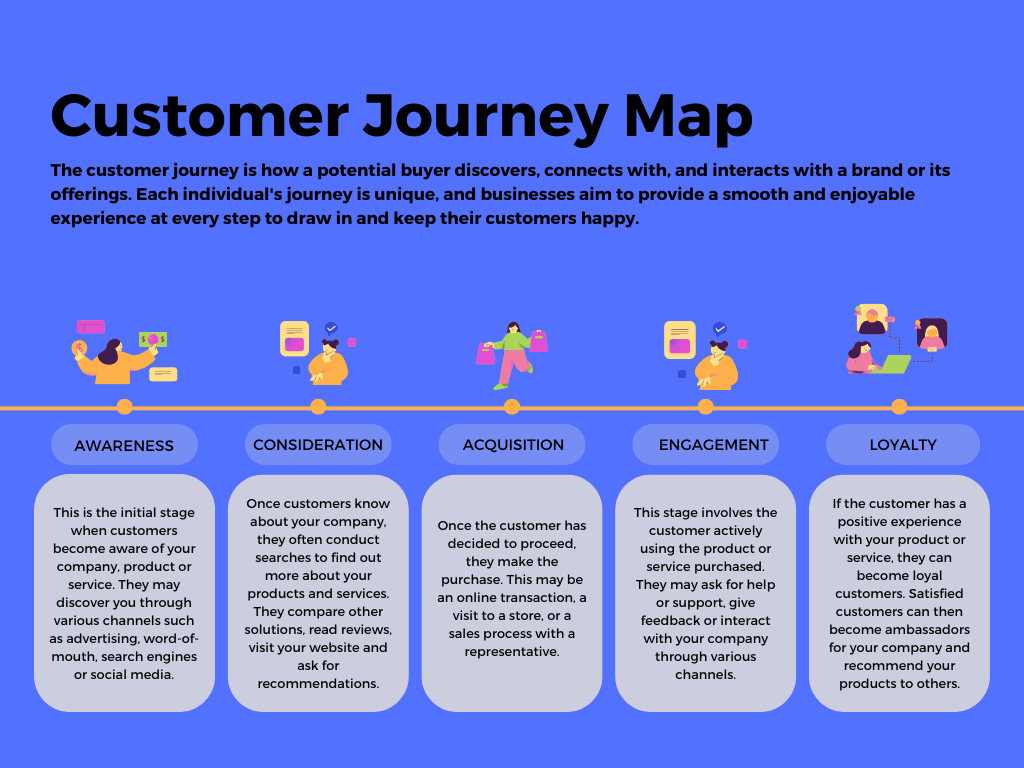What is Customer Experience?
Customer experience (CX) refers to the entirety of interactions between a customer and a company, from the first point of contact to the final purchase. It plays a critical role in business strategy, directly impacting customer satisfaction and loyalty. CX includes all aspects of customer interaction with a company, such as service quality, ease of use of the product or service, and the overall impression the customer has of the company.
A positive customer experience meets or exceeds customer expectations, leaving them with a favorable impression of the business. It can be measured through various means, such as customer satisfaction surveys, analysis of customer feedback, and direct observation of customer interactions. Understanding what contributes to a good CX is crucial for companies to continuously improve their offerings.
Naturally, a positive customer experience can lead to increased customer loyalty, while a negative experience can result in customer loss.
When does Customer Experience begin?
CX begins at the very first point of contact between a customer and a company. This can happen in various ways, such as when a customer sees an advertisement, visits the company’s website, or contacts the customer service department. From this initial point of contact, the customer starts to form emotions and expectations about the company.
This experience continues throughout the entire customer journey with the business, from initial product or service research to purchase, usage, and even post-purchase. Every customer interaction with the company contributes to their overall experience. Therefore, it is crucial for companies to ensure that each touchpoint with the customer is positive and contributes to an overall favorable customer experience.
Difference between Customer Service and Customer Experience
Customer service focuses on direct interactions between a company and its customers, typically involving problem resolution or providing information. Its primary goal is to ensure maximum customer satisfaction. However, customer service is just one aspect of the overall customer experience.
Customer experience encompasses all interactions a customer has with a business. This includes not only customer service but also elements like the ease of navigating the website (user experience), product quality, and relationship management. CX offers a more holistic view of the customer relationship.
It is possible to have excellent customer service but a poor customer experience if other elements fall short. Conversely, an exceptional customer experience can compensate for less-than-perfect customer service. For optimal satisfaction, customer service and customer experience must be viewed as complementary elements.
The importance of Customer Experience
Whether in B2B or B2C, CX has become a key differentiator and a competitive advantage for businesses. In a world where products and services are increasingly commoditized, CX is often the only way for a company to stand out from competitors, which is where customer relationship management comes into play.
Providing a satisfactory customer experience can positively impact customer loyalty, retention rates, and sales growth. On the other hand, a disappointing customer experience can quickly lead to customer loss and damage a company’s reputation. Therefore, gathering customer feedback is crucial for continuously improving the customer experience.
Furthermore, an outstanding customer experience can significantly contribute to positive word-of-mouth, which plays a key role in attracting new customers. This is where relational marketing becomes essential.
The growing importance of CX in marketing strategies
With the rapid evolution of technologies and consumer expectations, the role of customer experience in marketing strategies is increasingly important. Today’s consumers expect frictionless interactions with brands, and those unable to meet these expectations risk losing customers to more agile competitors. In fact, a PwC survey found that 73% of consumers say CX is an important factor in their purchasing decisions. Additionally, 65% of consumers find a positive experience with a brand to be more influential than great advertising.
In an increasingly digital world, customer experience extends far beyond face-to-face interactions. It now includes all online interactions, such as those on social media, mobile apps, websites, and more. This is where user experience becomes critical.
As a result, today’s marketing strategies must consider customer experience at every stage of the customer journey. This involves not only meeting customer expectations but also anticipating their needs and exceeding them whenever possible. This is where customer loyalty reveals its full potential, creating strong relationships and offering memorable experiences that inspire trust and unwavering loyalty.
What are the key challenges of Customer Experience?
Customer experience is a major challenge for businesses in the digital age. Customers now have access to a multitude of communication and interaction channels, requiring companies to manage customer relationships effectively and consistently across all these channels. This demands a deep understanding of customers and the ability to use this knowledge to offer relevant products and services.
Customer expectations have also evolved. They now expect a personalized user experience tailored to their specific needs, requiring the ability to collect and analyze customer feedback. Additionally, customer experience is a key differentiator in increasingly competitive markets. Companies that strive to create exceptional customer experiences are poised to outperform competitors and capture new markets.
How to improve CX?
Improving customer experience requires listening to customer feedback and understanding their expectations and needs. This can be done through surveys, interviews, or data analysis. Once customer expectations and needs are understood, it’s important to define a clear vision of the customer experience the company wants to provide. This vision should be shared across all stakeholders within the company.
Customer relationship management is a crucial aspect of improving customer experience. This involves setting up processes and tools to manage customer interactions effectively and respond promptly and efficiently to requests and complaints. Finally, it’s vital to regularly measure the effectiveness of these initiatives using specific KPIs, such as the Net Promoter Score (NPS), customer satisfaction rate, or customer retention rate.
Customer Journey Mapping

Customer journey mapping is an essential tool for understanding and improving CX. It helps visualize the different steps customers take when interacting with a business, from initial contact to purchasing a product or service, including after-sales service. This deep understanding of the customer journey helps identify friction points and areas for improvement.
Journey mapping also helps align different departments within the company around customer experience. By understanding how customers interact with the various channels of the company, it’s possible to ensure a consistent and high-quality experience across all touchpoints. This may involve implementing processes and technologies to facilitate customer interactions or training employees to respond effectively to customer needs.
Finally, journey mapping can also help identify key moments that can significantly impact customer satisfaction. These moments can be leveraged to create memorable experiences and strengthen the relationship with customers. For example, effective after-sales service can turn a negative experience into a positive one, thus increasing customer loyalty.
Cross-functional collaboration and service integration
Cross-functional collaboration and service integration are key strategies to optimize customer satisfaction. By fostering cooperation between different departments, a better understanding of the customer journey and improved user experience is achieved. Customer service, relationship marketing, and customer relationship management (CRM) are all interconnected and must work together to ensure quality customer interactions.
Service integration allows for better customer relationship management by promoting communication and collaboration. Breaking down silos enables information about the customer journey and user experience to flow more freely, allowing for quicker and more effective responses to customer feedback.
Cross-functional collaboration encourages innovation and continuous improvement of user experience. By sharing knowledge and skills between departments, businesses can develop more tailored solutions to customer needs, improving satisfaction and fostering customer loyalty.
Sharing progress and demonstrating action
Communicating improvements made based on customer feedback shows the company’s commitment to customer satisfaction and loyalty. This communication builds trust in the company’s customer service and relationship marketing efforts.
Transparency in communication is essential. Customers need to feel that their feedback is valued and that the company is committed to continually improving CX. Clear, precise communication about the actions taken to enhance customer satisfaction is a key element of customer loyalty.
Measuring and evaluating CX
Evaluating CX is essential in any customer retention strategy. This measurement helps identify the strengths and weaknesses of customer interactions and implement targeted improvements. It’s important to understand that evaluating CX goes beyond data collection; it also involves analyzing the data to extract actionable insights.
CX can be measured in various ways, depending on the company’s specific goals. Customer satisfaction surveys, for example, provide valuable insights into how customers perceive their interactions with customer service. Other methods, such as tracking online behaviors, can help identify customer trends and behavior patterns.
It’s also important to note that CX evaluation should not be a one-time activity. Instead, it should be a continuous process, allowing businesses to track changes in customer perceptions and attitudes over time. This enables companies to remain agile and responsive to evolving customer expectations.
Key CX KPIs and metrics
Several KPIs and metrics can be used to measure CX. Among the most commonly used are Net Promoter Score (NPS), Customer Satisfaction Score (CSAT), and Customer Effort Score (CES). These three metrics provide valuable insights into how customers perceive their interactions with the company.
For instance, NPS measures the likelihood that a customer would recommend the company to others, based on a scale of 0 to 10.
CSAT measures overall customer satisfaction with the company, typically asking customers to rate their satisfaction on a scale of 1 to 5.
CES measures the effort a customer had to exert to obtain a service or resolve a problem, by asking customers to rate the level of effort required to interact with the company.
In conclusion, CX is essential for the long-term survival of your business. The world is changing at a dizzying pace, and if you don’t stay up to date with the latest trends and technologies, your business will eventually fail. This is why focusing on CX is so important. Ensuring an exceptional experience for every customer will make the difference between success and failure.
At Prodware, we specialize in helping businesses create seamless, impactful customer journeys through tailored digital solutions. From optimizing interactions across all touchpoints to leveraging the latest technologies, we ensure your customer experience is not just good—but exceptional. Let us help you build loyalty, boost retention, and drive growth.






